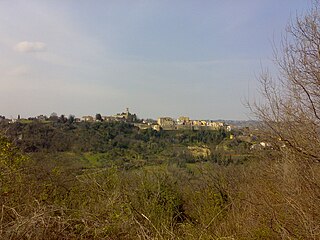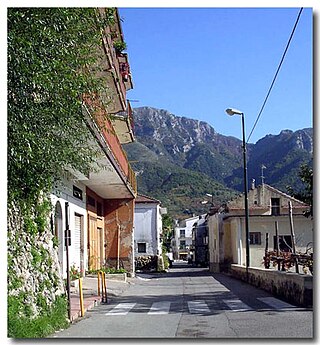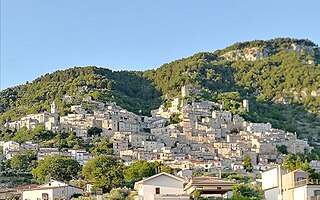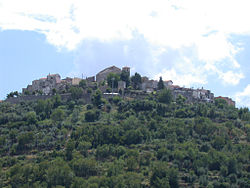Formia is a city and comune in the province of Latina, on the Mediterranean coast of Lazio, Italy. It is located halfway between Rome and Naples, and lies on the Roman-era Appian Way.

Itri is a small city and comune the province of Latina, Lazio, central Italy.

Fondi is a city and comune in the province of Latina, Lazio, central Italy, halfway between Rome and Naples. As of 2017, the city had a population of 39,800. The city has experienced steady population growth since the early 2000s, though this has slowed in recent years.

Alvito is a town and comune in central Italy, in the province of Frosinone, south of Rome in the Lazio region. Its territory is included in the Abruzzo, Lazio and Molise National Park.

Formello is a comune (municipality) in the Metropolitan City of Rome Capital. It is located southwest of the Monti Sabatini, within the Regional Park of Veii. The communal territory sits on large deposits of tuff, which is intensively mined in the area.

Teano is a town and comune in the province of Caserta, Campania, southern Italy, 30 kilometres (19 mi) northwest of Caserta on the main line to Rome from Naples. It stands at the southeast foot of an extinct volcano, Rocca Monfina. Its St. Clement's cathedral is the see of the Roman Catholic Diocese of Teano-Calvi, which started as the Diocese of Teano circa AD 300.

Arce is a comune (municipality) in the province of Frosinone, in the region of Lazio, Italy. it is an agricultural centre located on a hill overlooking the Via Casilina, in the Latin Valley and in the middle valley of the Liri.

Orbetello is a town and comune in the province of Grosseto (Tuscany), Italy. It is located about 35 kilometres (22 mi) south of Grosseto, on the eponymous lagoon, which is home to an important Natural Reserve.

Capestrano is a comune and small town with 885 inhabitants (2017), in the Province of L'Aquila, Abruzzo, Italy. It is located in the Gran Sasso e Monti della Laga National Park.

Monte San Biagio is a town and comune in the province of Latina, in southern Lazio (Italy). It is located on the slope of a hill part of the Monti Ausoni. Until 1862 it was known as Monticello.

Santi Cosma e Damiano is a town and comune in the province of Latina, in the Lazio region of central Italy, whose territory is located partly in the Monti Aurunci area and partly in the Garigliano plain.

Tagliacozzo is a town and comune in the province of L'Aquila, Abruzzo, central Italy. It is one of I Borghi più belli d'Italia.

Ari is a town and comune in the province of Chieti, Abruzzo, south-eastern Italy.

Tramonti is a town and comune in the province of Salerno in the Campania region of south-western Italy. It is located in the territory of the Amalfi Coast.

Gradoli is a comune (municipality) in the Province of Viterbo in the Italian region of Latium, located about 100 kilometres (62 mi) northwest of Rome and about 35 kilometres (22 mi) northwest of Viterbo.

Agosta is a comune (municipality) in the Metropolitan City of Rome in the Italian region of Latium, located about 45 kilometres (28 mi) east of Rome.
Gallicano nel Lazio is a comune (municipality) in the Metropolitan City of Rome in the Italian region of Latium, located about 25 kilometres (16 mi) east of Rome at the feet of the Monti Prenestini.

Sacrofano is a comune (municipality) in the Metropolitan City of Rome in the Italian region of Latium, located about 25 kilometres (16 mi) north of Rome. Located near the Monti Sabatini, at the feet of an extinct volcano, it is included in the Regional Park of Veii.

Esperia is a comune (municipality) in the Province of Frosinone in the Italian region Lazio, located about 110 kilometres (68 mi) southeast of Rome and about 40 kilometres (25 mi) southeast of Frosinone. It is located within the Monti Aurunci Natural Park.

Pesche is a comune (municipality) in the Province of Isernia in the Italian region Molise, located about 30 kilometres (19 mi) west of Campobasso and about 5 kilometres (3 mi) northeast of Isernia. As of 31 December 2004, it had a population of 1,459 and an area of 12.7 square kilometres (4.9 sq mi).






















